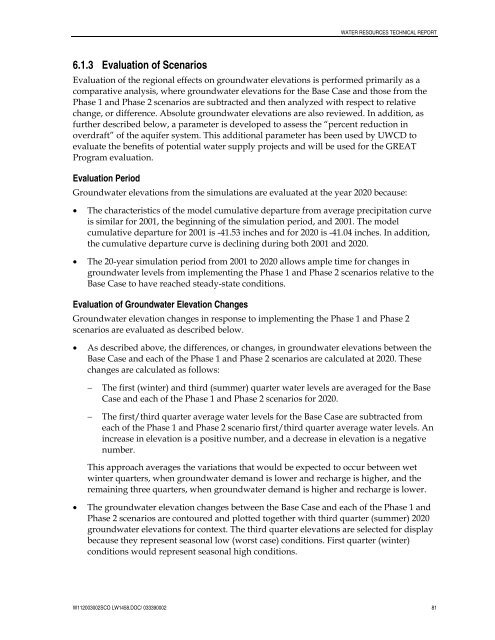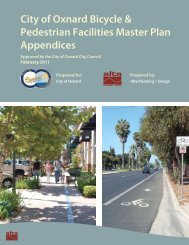View File - Development Services - City of Oxnard
View File - Development Services - City of Oxnard
View File - Development Services - City of Oxnard
Create successful ePaper yourself
Turn your PDF publications into a flip-book with our unique Google optimized e-Paper software.
WATER RESOURCES TECHNICAL REPORT6.1.3 Evaluation <strong>of</strong> ScenariosEvaluation <strong>of</strong> the regional effects on groundwater elevations is performed primarily as acomparative analysis, where groundwater elevations for the Base Case and those from thePhase 1 and Phase 2 scenarios are subtracted and then analyzed with respect to relativechange, or difference. Absolute groundwater elevations are also reviewed. In addition, asfurther described below, a parameter is developed to assess the “percent reduction inoverdraft” <strong>of</strong> the aquifer system. This additional parameter has been used by UWCD toevaluate the benefits <strong>of</strong> potential water supply projects and will be used for the GREATProgram evaluation.Evaluation PeriodGroundwater elevations from the simulations are evaluated at the year 2020 because:• The characteristics <strong>of</strong> the model cumulative departure from average precipitation curveis similar for 2001, the beginning <strong>of</strong> the simulation period, and 2001. The modelcumulative departure for 2001 is -41.53 inches and for 2020 is -41.04 inches. In addition,the cumulative departure curve is declining during both 2001 and 2020.• The 20-year simulation period from 2001 to 2020 allows ample time for changes ingroundwater levels from implementing the Phase 1 and Phase 2 scenarios relative to theBase Case to have reached steady-state conditions.Evaluation <strong>of</strong> Groundwater Elevation ChangesGroundwater elevation changes in response to implementing the Phase 1 and Phase 2scenarios are evaluated as described below.• As described above, the differences, or changes, in groundwater elevations between theBase Case and each <strong>of</strong> the Phase 1 and Phase 2 scenarios are calculated at 2020. Thesechanges are calculated as follows:−−The first (winter) and third (summer) quarter water levels are averaged for the BaseCase and each <strong>of</strong> the Phase 1 and Phase 2 scenarios for 2020.The first/third quarter average water levels for the Base Case are subtracted fromeach <strong>of</strong> the Phase 1 and Phase 2 scenario first/third quarter average water levels. Anincrease in elevation is a positive number, and a decrease in elevation is a negativenumber.This approach averages the variations that would be expected to occur between wetwinter quarters, when groundwater demand is lower and recharge is higher, and theremaining three quarters, when groundwater demand is higher and recharge is lower.• The groundwater elevation changes between the Base Case and each <strong>of</strong> the Phase 1 andPhase 2 scenarios are contoured and plotted together with third quarter (summer) 2020groundwater elevations for context. The third quarter elevations are selected for displaybecause they represent seasonal low (worst case) conditions. First quarter (winter)conditions would represent seasonal high conditions.W112003002SCO LW1458.DOC/ 033390002 81
















